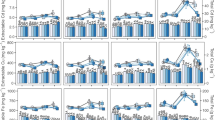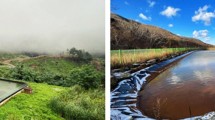Abstract
This study was carried out to evaluate longevity of available organic materials used for sulfate-reducing bacteria (SRB) activity in vertical flow ponds (VFPs) to treat mine drainage in South Korea. Spent mushroom compost samples (SMC) were tested as substrates in VFPs and analyzed for total organic carbon in VFPs, and were collected to analyze total organic carbon (TOC), T-N, T-P, K, metals and residual cellulose to check the longevity assessment. Chemical analysis revealed that the average contents of Fe, Al and Mn in SMC of VFPs were 19,907, 32,137 and 434 mg/kg, respectively. The contents of Fe and Al in SMC of VFPs were much higher than those of the unused SMC (control), but to the contrary, those of Mn showed a reversed tendency. Average TOC content of the controls was 64.19% but in one of the VFP substrates was as low as 15.92%. This might be resulted from SRB consumed the available organic carbon in SMC as VFPs system aged. Contents of T-N in VFPs tended to decrease as VFPs aged. The residual cellulose ranged from 3.88 to 6.72% (g/g). There existed a negative relationship between residual cellulose contents and ages of VFPs. Assuming that SMC in all VFPs had similar compositions when the VFPs were initially established, trend analysis predicted that the amount of carbon source for SRB might be available for 12–15 years further, depending on VFPs.








Similar content being viewed by others
References
Chang, I. S., Shin, P. K., & Kim, B. H. (2000). Biological treatment of acid mine drainage under sulphate-reducing conditions with solid waste materials as substrate. Water Research, 34, 1269–1277.
Cheong, Y. W., Min, J. S., & Kwon, K. S. (1998). Metal removal efficiencies of substrates for treating acid mine drainage of the Dalsung mine, South Korea. Journal of Geochemical Exploration, 64, 147–152.
Cocos, I. A., Zagury, G. J., Clement, B., & Samson, R. (2002). Multiple factor design for reactive mixture selection for use in reactive walls in acid mine drainage treatment. Water Research, 36, 167–177.
Elliott, P., Ragusa, S., & Catcheside, D. (1998). Growth of sulfate-reducing bacteria under acidic conditions in an upflow anaerobic bioreactor as a treatment system for acid mine drainage. Water Research, 32(12), 3724–3730.
Gibert, O., de Pablo, J., Cortina, J. L., & Ayora, C. (2004). Chemical characterization of natural organic substrates for biological mitigation of acid mine drainage. Water Research, 38, 4186–4196.
Gusek, J. J., & Wildeman, T. R. (2002). A new millennium of passive treatment of acid rock drainage: Advances in design and construction since 1988. In Proceedings of the 2002 national meeting of the American society for mining and reclamation, June 9–13, Lexington, Kentucky. Lexington, KY: ASMR.
Hedin, R. S. (2008). Iron removal by a passive treating alkaline coal mine drainage. Mine Water and the Environment. doi:10.1007/s10230-008-0041-9.
Hedin, R. S., Nairn, R. W., & Kleinmann, R. P. (1994). Passive treatment of coal mine drainage (pp. 11–24). US Bureau of Mines, Information Circular 9389.
Henrot, J., & Wieder, R. K. (1990). Processes of iron and manganese retention in laboratory peat microcosms subjected to acid mine drainage. Journal of Environmental Quality, 19, 312–320.
Kaksonen, A. H., & Puhakka, J. A. (2007). Sulfate reduction based bioprocesses for the treatment of acid mine drainage and the recovery of metals. Engineering in Life Sciences, 7(6), 541–564.
Kepler, D. A., & McCleary, E. C. (1994). Successive alkalinity-producing systems (SAPS) for the treatment of acidic mine drainage. In Proceedings, international land reclamation and mine drainage conference (pp. 195–204). April 24–29, 1994, USDI, Bureau of Mines SP 06A-94. Pittsburgh, PA.
Kolmert, A., & Johnson, D. B. (2001). Remediation of acidic waste waters using immobilised, acidophilic sulfate-reducing bacteria. Journal of Chemical Technology and Biotechnology, 76, 836–843.
Marsden, W. L., Gray, P. P., Nippard, G. J., & Quinlan, M. R. (1982). Evaluation of the DNS method for analysing lignocellulosic hydrolysates. Journal of Chemical Technology and Biotechnology, 32, 1016–1022. doi:10.1002/jctb.5030320744.
Neculita, C. M., Zagury, G. J., & Bussiere, B. (2007). Passive treatment of acid mine drainage in bioreactors using sulfate-reducing bacteria: Critical review and research needs. Journal of Environment Quality, 36, 1–16.
Pierzynski, G. M. (Ed.) (2000). Methods of phosphorus analysis for soils, sediments, residuals and waters. Southern Coop. Series Bull. No. 396. North Carolina State Univ., Raleigh, NC, 102 p.
Postgate, J. R. (1984). The sulfate-reducing bacteria (2nd ed.). Cambridge: Cambridge University Press.
Prasad, D., Wai, M., Berube, P., & Henry, J. G. (1999). Evaluating substrates in the treatment of acid mine drainage. Environmental Technology, 20, 449–459.
Westerman, R. L. (1990). Soil testing and plant analysis (3rd ed.). Madison, WI, USA: Soil Science Society of America.
Zagury, G. J., Kulnieks, V. I., & Neculita, C. M. (2006). Characterization and reactivity assessment of organic substrates for sulphate-reducing bacteria in acid mine drainage treatment. Chemosphere, 64, 944–954.
Acknowledgments
This research was supported by the Basic Research Project (11-3411) of the Korea Institute of Geoscience and Mineral Resources(KIGAM) funded by the Ministry of Knowledge Economy of Korea.
Author information
Authors and Affiliations
Corresponding author
Rights and permissions
About this article
Cite this article
Cheong, YW., Hur, W., Yim, GJ. et al. Longevity of organic layers of vertical flow ponds for sulfate reduction in treating mine drainages in South Korea. Environ Geochem Health 34 (Suppl 1), 115–121 (2012). https://doi.org/10.1007/s10653-011-9404-4
Received:
Accepted:
Published:
Issue Date:
DOI: https://doi.org/10.1007/s10653-011-9404-4




